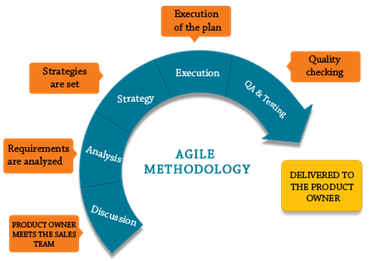



2015 has seen a great evolution in the testing space with upcoming trends in IT industry. With the start of Service Oriented Architecture, increase in virtualization and adoption of cloud computing, today testers have a lot of new aspects to consider and going forward industry experts and specialists expect lot more interesting trends in the software testing domains and it becomes a challenge. So are we ready to knock down these challenges? One trend is to integrate testing earlier in the development cycle with testing methods like Agile. This often involves companies establishing a Testing Center of Excellence (TCoE) to coordinate testing methodologies with business development in order to build products reliably from the scratch. The other trend is toward independent testing options, either via a third-party firm or crowdsourced testers. Independent testing can offer greater testing coverage and costs less than an in-house QA team.
Software testing is evolving rapidly:
The introduction of new architectures such as service-oriented architecture (SOA), increase in virtualization and inclination towards cloud has shaken up the industry and has compelled testers to consider new aspects. Additionally, focus on DevOps has dramatically changed the face of IT.
There are several important trends in software testing world that will alter the landscape that testers find themselves in today:
- Mobile application testing (Rapid growth in Mobile testing)
- Cloud-based Testing (Virtualization and Cloud Computing)
- Testing in the Agile Development Environment
- Context-driven test
- Security Testing
- Crowdsourced testing
- Proliferation of open-source testing tools
- Tester Certification
1. Mobility Application Testing (Rapid growth in Mobile testing):
With the surge of mobile devices in the market, there is a significant increase in mobile testing activity, including functionality, performance and security of mobile applications and devices. Some of the applications today are using the power of cloud to communicate with the ERP systems. In such situations, data security is of paramount importance. The multitude OS used on the handsets adds to the challenge calling for functionality testing and integration testing.
Mobile devices have become a major part of many Mobile App Testing organizations’ digital development strategy, but many businesses lack the testing specialists, tools, and consistent methodology needed for effective mobile development. Mobile market growth is nothing new; the mobile industry has been skyrocketing for several years, as consumers spend more time on multiple devices and consume mobile-only content. According to the World Quality Report, 55% of organizations now test mobile apps, up from 31% last year. Yet, 56% lack effective testing procedures. Security also remains a key consideration for mobile testing. With a growing number of devices interacting in the Internet of Things, safety must be a top concern in QA without compromising the very mobility and wireless access that enable mobile devices. While increased mobile usage remains the future for consumers, businesses have yet to develop effective testing procedures that can achieve effective test coverage without falling prey to the accelerating development lifecycle.
2. Cloud-based Testing (Virtualization and Cloud Computing):
As cloud computing becomes an increasing part of the IT mainstream with about 26% of software applications to be hosted on cloud in 2015, IT professionals and experts see a positive growth in the adoption of cloud based testing. For the simple reason, cloud infrastructure offers a convenient solution unlike other test environments which can be difficult and expensive to build and maintain. There are concerns related to data security and performance in cloud based environments which organizations view as a medium term challenge that will be soon addressed. Cloud testing is also flexible, allowing businesses to scale up or down as part of a dynamic testing strategy.
3. Testing in the Agile Development Environment:
Companies are working hard to build a holistic testing approach that fits with the agile development methodology and brings in right test tools. Continuous testing is something that we will be seeing a lot as companies today are more focused on getting into the delivery phase without having to wait for long. Testing in production is one approach that will be commonly used by testers in order to provide a constant flow of updates on how the software is shaping up with respect to its features and value to business. Agile methods are in the mainstream. They offer both challenges and opportunities for testers. Agile does not mean one thing, but a collection of many related things. Integration of testing best practices into Agile methodologies remains a challenge. Agile Scrum is another development that is changing the manner in which testers operate. This is a flexible, holistic product development strategy that encourages teams to self-organize and communicate regularly. In other words, testers work closely with developers and obtain early involvement and feedback on a project.
4. Context-driven Testing
A one-size fits all approach is not something that we can rely on when it comes to testing of software applications. There is a need to be adaptable in the event the context changes. This has made context-driven software testing a trend that we expect will emerge strongly in the coming years. According to software testing leaders in the industry, the most successful testers in the future will be the ones that can bring the most skills to the table for any given context or business situation.
5. Security Testing
The increased connectivity of data and information systems along with the rise of cloud based computing and the phenomenon of Internet of Things taking center stage in the IT industry, security testing of software applications is going to be of top priority.
6. CrowdSourced Software testing
This form of testing is slowly gaining popularity as it helps organizations thrift its budget for software development. It is helpful in situations wherein the testing team may not have all the resources to test the software in different environments and in different scenarios.
All these trends are testimony of the fact that the software testing industry is evolving at an enormous pace. What will be interesting for us to watch is how this industry is going to adapt itself to the growing demands of technology and innovation in the IT sector.
7. Open-source testing tools
Agile methods have spun-off many useful open-source test tools like X-Unit, Selenium etc. Test automation skills are essential to take advantage of these tools. Integrated development environments often include related or similar tools.
8. Tester Certification
Tester certification has existed since the 1980s, The ISTQB program brought openness, inclusivity, and global reach. Certification is not about training, but about establishing knowledge. ISTQB program includes a career path. Certification will lead ultimately to an agreement on best practices throughout testers’ careers. Certification is part of professionalization.
- Certified Software Tester (CSTE)
- ISTQB certification
- V & V Manual testi8ng Certification (Organization level Certification)




 View Previous Blog
View Previous Blog




